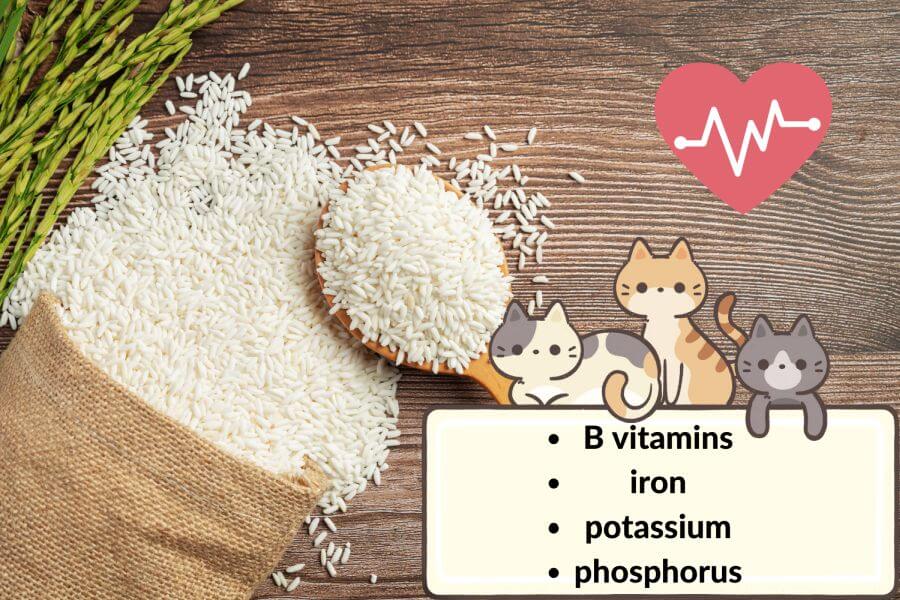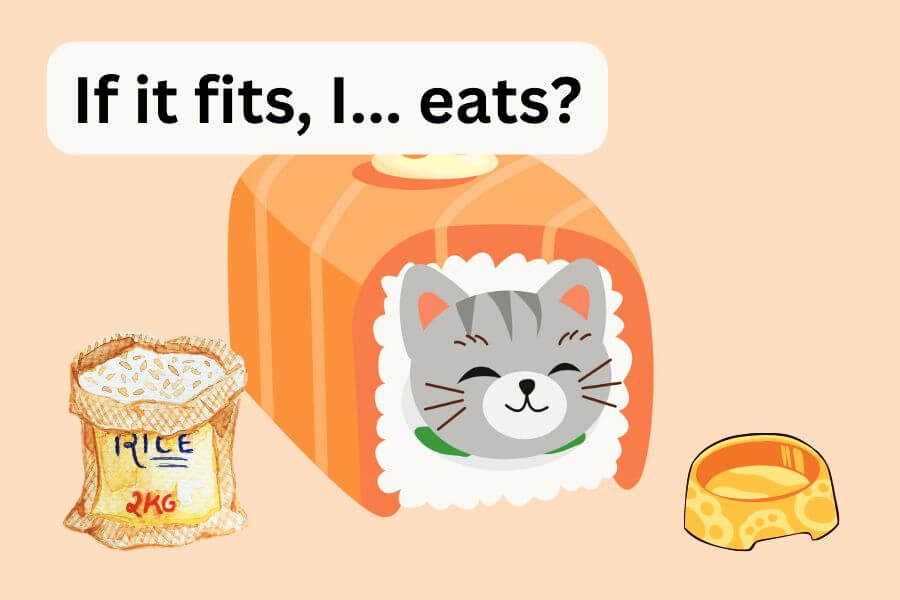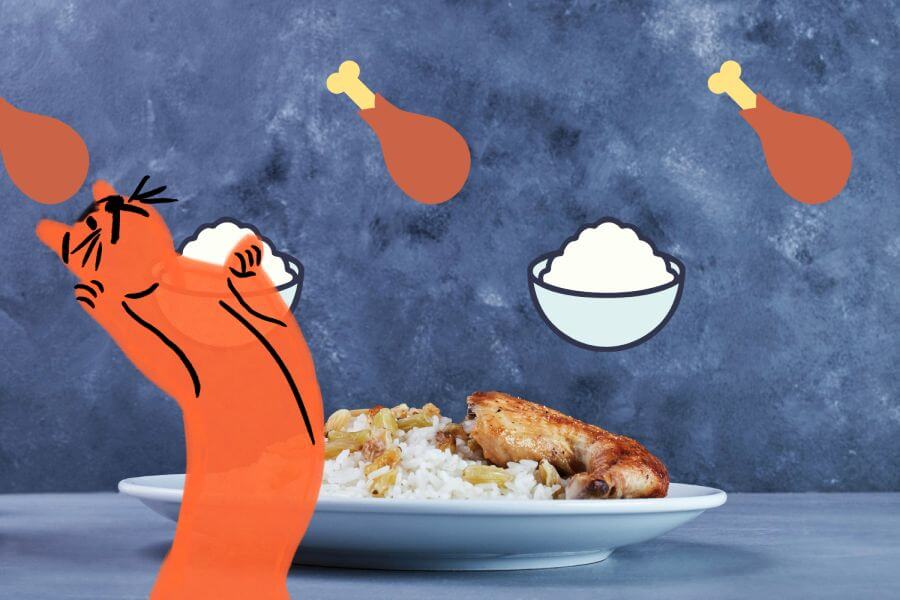Long Story Short
- It is a-okay to give your cat some rice 🍚✔️
- Cats can eat plain white rice with few ill effects other than possible weight gain (must be cooked, though)✔️
- Don’t add any extras such as salt or spices (tummy troubles alert!) ⚠️
- Rice allergies are rather rare, but possible. If you notice any symptoms, it’s vet time! 👨⚕️
Health Benefits of Rice
Did you know that rice isn’t just a bland side dish? It’s actually packed with all sorts of nutrients, like thiamin, niacin, and vitamin B6 (especially in brown or fortified varieties!). Plus, it’s got key minerals like iron, potassium, and phosphorus, making it a great addition to any meal.
But here’s where it gets really interesting: rice comes in all sorts of fun varieties! Brown rice is the unprocessed, nutty-flavored option that happens to be the most nutritious. With brown rice, you’re getting all the vitamins we mentioned earlier, plus protein and dietary fiber. On the other hand, white rice has had the bran and germ removed – think, a softer texture and milder flavor.

We have to rain on this rice parade, though. Sometimes, even though some food is healthy for people, it may be toxic to our feline friends. Can cats eat rice? Or is this human food harmful to them?
Is Rice Good for Cats?
Well, the answer isn’t black and white… it’s more like brown and white (hey, rice puns can be good too!).
Here’s the deal: boiled rice is a safe option for your feline friend, as long as you keep the salty seasonings to a minimum. But beware, if you’re serving up some fried or saucy rice, it might not be the healthiest choice for your cat. So, make sure to opt for plain ol’ boiled rice without any additives.
Friendly Reminder 😺
Rice can be a yummy snack for your cat, but it shouldn’t be the main ingredient of your cat’s diet. Yes, we also mean the commercial cat food. If grains are first on the list, that’s a no-no.
Is Plain White Rice Bad for Cats?
There’s no evidence that rice is inherently toxic to cats. Phew! But hold your niblets, if your cat manages to sneak in a couple of bites, you might see some not-so-fun consequences (mostly tummy troubles). Cats are obligate carnivores. Their digestive system is specifically designed to break down proteins, not complex carbohydrates like rice.
Yup, they’re the ultimate meat-lovers! Think of it this way, if you were to eat a whole box of mac and cheese, how would you feel? Not so great, right? The same goes for our furry friends. Too much rice can lead to diarrhea, a bellyache, or even some extra kitty cushioning. And trust us, no cat wants that.

What About Brown Rice?
Is brown rice any better for your feline friends than white? Well, it turns out that brown rice is jam-packed with more nutrients than the boring old white one. But, paws up! One study found that a component found in the brown rice, called rice bran, actually decreases the taurine levels in your cat’s blood. Taurine is crucial for your kitty’s health, as it’s an essential amino acid that can only be found in their food.
So, can cats eat rice if it’s brown? Of course, they can! Maybe, not as a part of their main food, but surely as a snack every now and then.
How to Feed Your Cat Rice?
Firstly, let’s make sure we’re not giving our cats any uncooked rice. Trust us, we know it might be tempting to let them nibble on that crunchy goodness, but it can actually lead to some serious tummy troubles. We’re talking about intestinal blockages here – and no one wants their kitty to go through that.
So, boil the rice first before serving it to your furry friend. It’s a small step that can make a big difference in your cat’s health.
Now, let’s talk portion control. Just like us humans, overeating can lead to some not-so-pleasant consequences for cats. Too much rice can cause constipation or diarrhea, and no one wants to deal with that stinky situation. So, start with small portions and see how your cat reacts. You know your cat best, so trust those instincts.

Caution ⚠️
Some cats may be allergic to rice, so watch out for any signs of an allergic reaction, such as sneezing, itchy skin, or diarrhea.
How Often Can I Give My Cat Rice?
Can cats eat rice on a regular basis? It would seem that they can, since it’s a popular filler in dry kibble. But at this point, we should know better. Cats need to have a high-protein diet to ensure they’re getting the nutrients they need. Rice and cats should meet no more often than twice a week. (And only once if it’s rice and chicken as a meal replacement.)
In Conclusion, Can Cats Eat Rice?
So, can cats eat rice? Yes, they can. They shouldn’t eat too much of it, but a few bites here and there are absolutely safe (as long as it’s cooked). It can also help them with an upset stomach! All in all, rice to the occasion (literally)!
Pros and Cons of Plain Rice for Cats
| PROS ✔️ | CONS ❌ |
| Rice is a good source of carbohydrates and essential vitamins and minerals. | Rice can cause weight gain if not fed in moderation. |
| It can be cooked and served as a stand-alone treat or mixed with wet cat food. | Brown rice can cause your cat to lose taurine and develop a deficiency. |
| It can help calm an upset stomach or soothe a burpy kitten. | Some cats may be allergic to rice, so watch out for any signs of an allergic reaction. |
Similar Posts:
- What Human Food Can Cats Eat? 7 People Foods for Cats
- Can Dogs Eat Rice? Are White Rice and Brown Rice Safe for Dogs?
- Can Cats Eat Corn or Corn Chips?
- Can Cats Eat Shrimp? Is Seafood Safe For Cats?
- Can Cats Eat Popcorn? Are Corn Kernels Safe?
- Can Cats Eat Turkey? Is Turkey Meat Safe for Cats?
- Can Cats Eat Bread? Choose the Best Diet for Your Feline Friend!
- Can Cats Eat Onions and Chives? Let’s Unleash the Truth!

